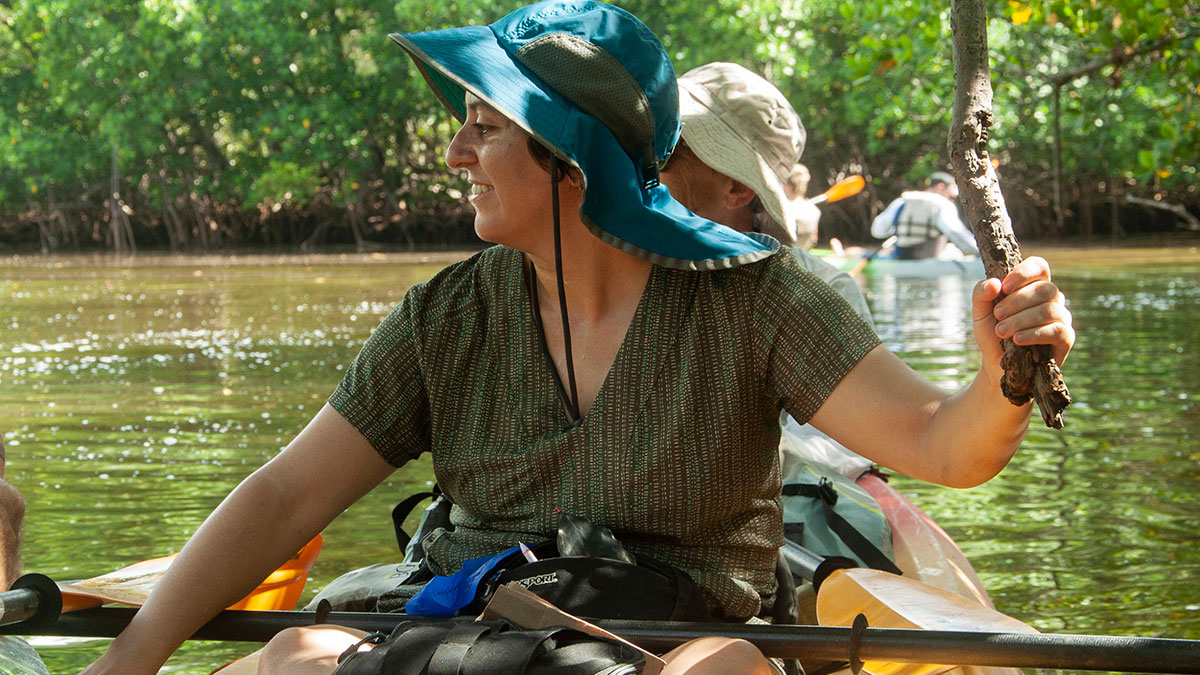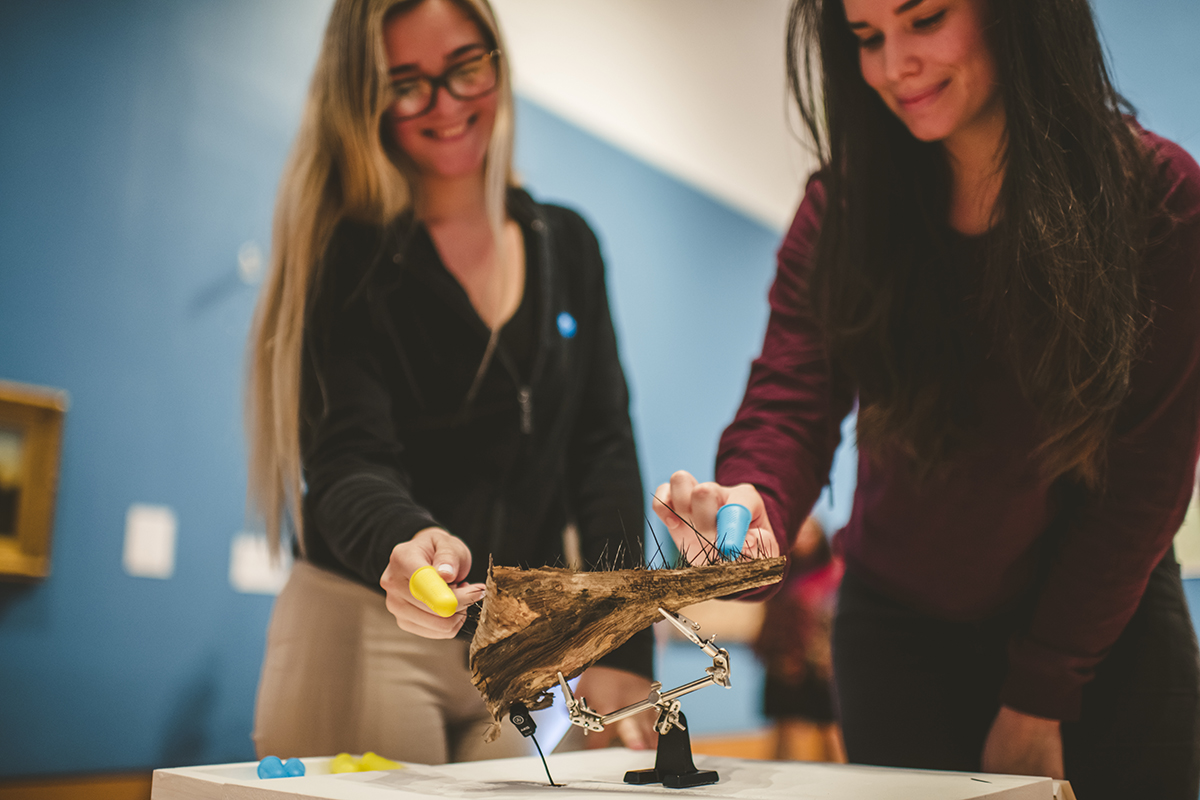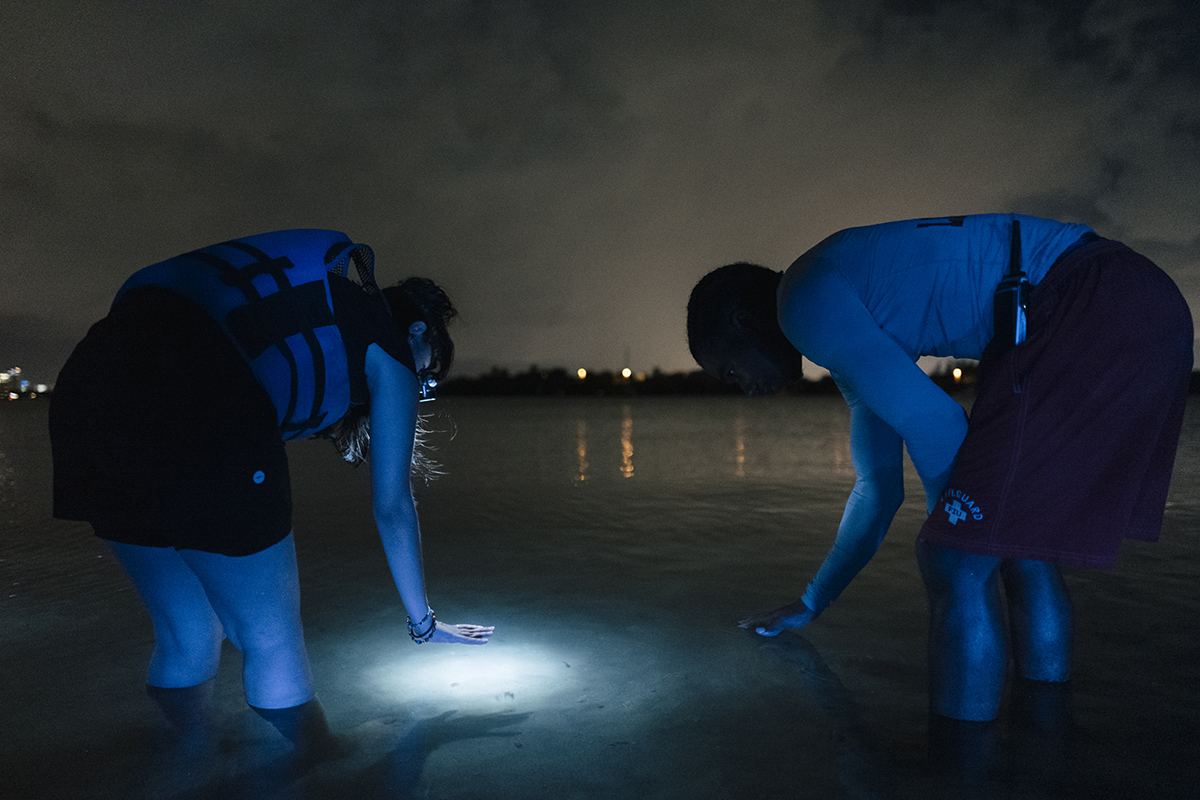
“5 Questions” is an ongoing series with School of Art alumni who are transforming art, culture, and technology, exploring their creative practices, career milestones, and Carnegie Mellon memories.
Fereshteh Toosi’s participatory artwork seeks to reconnect to the layers of human and other-than-human life, showing the interconnectedness of ecology and human history. Examples of their projects include a walking performance about lithium mining, an overnight camp for broadcasting the dawn chorus of birds, and an experimental documentary featuring food heritage stories called Shoebox Lunch. Their most recent project, School of Oil and Water, launches on October 16 and includes several current and former CMU community members.
Toosi’s work has been supported by the University of Pennsylvania’s Program in Environmental Humanities, a Miami Live Arts Lab Alliance residency, and The Ellies Creator Award, among many others. They are an Associate Professor in the digital area of the Art and Art History at Florida International University.
1
Tell us about how your work seeks to connect the natural world with our lived experiences and histories.
It’s impossible to make a distinction between the natural world and our experiences and histories as humans. There’s really no separation. It’s not a new concept, it’s at the core of many Indigenous knowledge systems. Over time I’ve witnessed more popular awareness and a greater understanding of this intersectionality, which is at the heart of my work.
My recent projects explore interspecies public health and our entangled futures. Since grad school at CMU, I’ve completed various trainings in environmental urban design, horticultural therapy, environmental education, and forest therapy. All of these modalities have influenced my participatory eco-art, which manifests in various forms such as guided walks, hands-on gardening activities, and kayak excursions, among others.
This month I’m launching the School of Oil and Water, it’s part of a larger body of work called Oil Ancestors which probes our emotional attachment to oil and our perception of time in relation to it. It actually features several current and former CMU community members.
During a time when many are overwhelmed with feelings of fear, sadness, or rage about our collective loss due to ecological degradation, my intention isn’t to criticize people’s behavior or invoke a utopic future that may no longer be possible. Instead, I use playful, poetic approaches to engage the audience in contemplation and self-reflection.
2
Your work often uses older technologies such as audio recording or videos with a small file size. At a time when there’s a lot of focus on the new and cutting edge, why use more simple technology?
I definitely use newer technologies but in my role as an educator I’ve become sensitive to the harm that’s caused by corporate planned obsolescence. Perhaps what I’m resistant to is the speed and acceleration that’s imposed on us as we feel pressured to early adoption. There are ecological costs to the desire for newness, speed, 24-7 streaming, and high resolution. Because I prioritize care and accessibility, I might choose simpler technology for a project because it allows me to be more critically aware of its affordances.
A lot of my older art projects have disappeared because the platforms or technology changed so much. Emerging media is volatile, by that I mean that it shifts quickly and requires constant learning and active preservation. It’s already hard enough to maintain a presence when ephemeral forms like performance and live art are at the core of my practice, so I often turn to more stable media.

3
Your work often engages with participants in small groups or one-on-one. What is that experience like for you as an artist?
The experience is positive for me because I really prefer small groups in my personal social interactions! Think about when you’re at a big dinner party and you try to have a single discussion. Even if everyone is seated together in the round, there’s a threshold number where things break down. Unless it’s an environment with a facilitator, conversation naturally moves to smaller groups.
On a practical level, it does affect me because organizations still struggle to deal with these types of projects, since arts organizations tend to be very invested in reaching wide audiences. I remember going to a performance at the Warhol Museum where you had to make an appointment and you were blindfolded alone in a room while a performer tickled you with a feather and other such things. I don’t remember the name of the artist but it was impactful. Don’t get me wrong, I absolutely love sinking back into the soft chair in a crowded film screening or theater production. Being in a collective audience in a public venue is one of my favorite things. But in my own work I’m experimenting with the ways in which the audience’s presence and engagement becomes vital.
Of course it’s not just about my experience. The methods of qualitative ethnographic research have been a part of my practice ever since I began using media like video and audio. One-on-one interviews are typical in oral history, traditional documentary media, and in the social sciences. There are so many ways that power dynamic has historically caused harm, but I’m going for a more experimental kind of engagement for the audience. Art circulates in an economy of attention, and there’s something special that happens when that attention is distributed among a small group or just between two individuals. Lately I’ve been doing more events that don’t even have an audience at all, because I’m interested in the way we can play and be together when it’s not about creating a spectacle for someone else.

4
Could you talk a bit about your time as a grad student at CMU’s School of Art? Are there any experiences you had as a student that stand out?
One of the best aspects of being a grad student at CMU was the richness of interaction between grads, undergrads, exchange students, and visiting scholars. As a grad student, some of my closest friends at CMU were in the BFA program. There were so many interesting experiences, big and small. Some of my fondest memories are sharing coffee from a moka pot bubbling in Betty Raas and Paul Steenberghe’s studio in CFA, they were visiting from the Netherlands and they did an ambitious project which involved printing on and circulating US currency. I remember doing a goofy workshop called DIY Grossology with another grad student, Shana Moulton, and the exhibit where BFA student Robin Hewlett was giving away all her belongings. Another grad, Mark Dixon, took apart a used Saab that he bought from one of the professors for a dollar and transformed it into a bunch of musical instruments. Then there was the time when a kooky race was happening on campus, which featured bicycles made out of kayaks. That partially inspired a performance project about the aquifer in Pittsburgh, which I developed with Carolyn Lambert. I could go on and on with stories like this, all of which were formative for me.
5
Do you have any advice to share with students?
In addition to building community in the School of Art, it’s important to get out of the studio. Consider how you can cultivate a relationship with Pittsburgh, which is an amazing city. Make and maintain connections with people beyond school, whether it’s family, friends, or co-workers. The integration of public practice in the CMU art curriculum helps with this, but not everything has to be for art. Place matters and you can learn a ton from off-campus experiences. You don’t even need to go that far. I remember protesting the US invasion of Iraq in 2003 with others from my grad cohort, and a group called Pink Bloque (who were friends with fellow grad Blithe Riley) was doing a workshop at the University of Pittsburgh. Dance on the streets, ride city buses to different neighborhoods, volunteer with an organization, chill out on a long walk in Frick Park.




